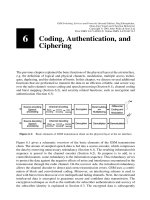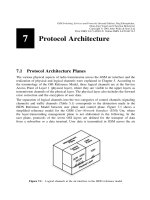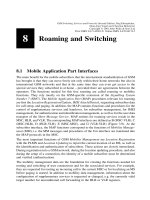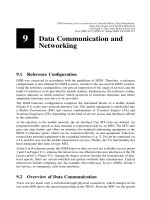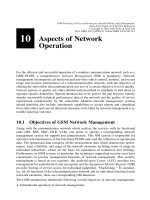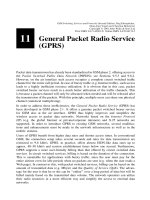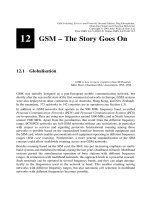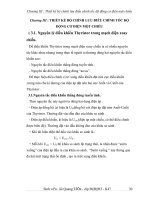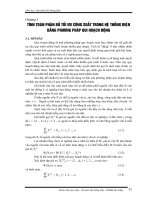Tài liệu GSM switching services and protocols P3 docx
Bạn đang xem bản rút gọn của tài liệu. Xem và tải ngay bản đầy đủ của tài liệu tại đây (383.69 KB, 17 trang )
System Architecture and
Addressing
3.1 General Description
GSM networks are structured hierarchically (Figure 3.1). They substantially consist of at
least one administrative region, which is assigned to a Mobile Switching Center (MSC).
Each administrative region is made up of at least one Location Area (LA). Sometimes the
LA is also called the visited area. An LA consists of several cell groups. Each cell group is
assigned to a Base Station Controller (BSC). Therefore for each LA there exists at least
one BSC, but cells of one BSC may belong to different LAs.
The exact partitioning of the service area into cells and their organization or administration
with regard to LAs, BSCs, and MSCs is, however, not uniquely determined and is left to
the respective network operator who thus has many possibilities for optimization. Figure
3.2 shows the system architecture of a GSM Public Land Mobile Network (PLMN) with
essential components. The hierarchical construction of the GSM infrastructure becomes
evident again. The cell is formed by the radio area coverage of a Base Transceiver Station
(BTS). Several base stations together are controlled by one BSC. The combined traf®c of
the mobile stations in their respective cells is routed through a switch, the Mobile Switch-
ing Center (MSC). Calls originating from or terminating in the ®xed network (e.g. the
Integrated Services Digital Network, ISDN [7]) are handled by a dedicated Gateway
3
Figure 3.1: GSM system hierarchy
GSM Switching, Services and Protocols: Second Edition. Jo
È
rg Eberspa
È
cher,
Hans-Jo
È
rg Vo
È
gel and Christian Bettstetter
Copyright q 2001 John Wiley & Sons Ltd
Print ISBN 0-471-49903-X Online ISBN 0-470-84174-5
Mobile Switching Center (GMSC). Operation and maintenance are organized from a
central place, the Operation and Maintenance Center (OMC). Several databases are avail-
able for call control and network management:
² Home Location Register (HLR)
² Visited Location Register (VLR)
² Authentication Center (AUC)
² Equipment Identity Register (EIR)
For all subscribers registered with a network operator, permanent data (such as the user's
service pro®le) as well as temporary data (such as the user's current location) are stored in
the HLR. In case of a call to a user, the HLR is always ®rst queried, to determine the user's
current location. A VLR is responsible for a group of LAs and stores the data of subscribers
who are currently in its area of responsibility. This includes parts of the permanent
subscriber data which have been transmitted from the HLR to the VLR for faster access.
But the VLR may also assign and store local data such as a temporary identi®cation. The
AUC generates and stores security-related data such as keys used for authentication and
encryption, whereas the EIR registers equipment data rather than subscriber data.
3.2 Addresses and Identi®ers
GSM distinguishes explicitly between user and equipment and deals with them separately.
According to this concept, which was introduced with digital mobile networks, mobile
equipment and users each receive their own internationally unique identi®ers. The user
3 System Architecture and Addressing
30
Figure 3.2: GSM system architecture with essential components
identity is associated with a mobile station by means of a personal chip card, the Subscri-
ber Identity Module (SIM). This SIM usually comes in the form of a chip card, which is
transferable between mobile stations. It allows to distinguish between equipment mobility
and subscriber mobility. The subscriber can register to the locally available network with
his or her SIM card on different mobile stations, or the SIM card could be used as a normal
telephone card in the ®xed telephone network. However, he or she cannot receive calls on
®xed network ports, but further development of the ®xed networks as well as convergence
of ®xed and mobile networks could make this possible, too. In that case, a mobile subscri-
ber could register at an arbitrary ISDN telephone and would be able to receive calls.
In addition, GSM distinguishes between subscriber identity and telephone number. This
leaves some scope for development of future services when each subscriber may be called
personally, independent of reachability or type of connection (mobile or ®xed). Besides the
personal identi®er, each GSM subscriber is assigned one or several ISDN numbers.
Besides telephone numbers and subscriber and equipment identi®ers, several other identi-
®ers have been de®ned; they are needed for the management of subscriber mobility and for
addressing all the remaining network elements. The most important addresses and identi-
®ers are presented in the following.
3.2.1 International Mobile Station Equipment Identity (IMEI)
The International Mobile Station Equipment Identity (IMEI) uniquely identi®es mobile
stations internationally. It is a kind of serial number. The IMEI is allocated by the equip-
ment manufacturer and registered by the network operator, who stores it in the Equipment
Identity Register (EIR). By means of the IMEI one recognizes obsolete, stolen, or nonfunc-
tional equipment and, for example, can deny service. For this purpose, the IMEI is
assigned to one or more of three categories within the EIR:
² The White List is a register of all equipment.
² The Black List contains all suspended equipment. This list is periodically exchanged
among network operators.
² Optionally, an operator may maintain a Gray List, in which malfunctioning equipment
or equipment with obsolete software versions is registered. Such equipment has
network access, but its use is reported to the operating personnel.
The IMEI is usually requested from the network at registration, but it can be requested
repeatedly. It is a hierarchical address, containing of the following parts:
² Type Approval Code (TAC): 6 decimal places, centrally assigned
² Final Assembly Code (FAC): 6 decimal places, assigned by the manufacturer
² Serial Number (SNR): 6 decimal places, assigned by the manufacturer
² Spare (SP): 1 decimal place
Thus, IMEI TAC 1 FAC 1 SNR 1 SP. It uniquely characterizes a mobile station and
gives clues about the manufacturer and the date of manufacturing.
3.2 Addresses and Identi®ers
31
3.2.2 International Mobile Subscriber Identity (IMSI)
When registering for service with a mobile network operator, each subscriber receives a
unique identi®er, the International Mobile Subscriber Identity (IMSI). This IMSI is stored
in the SIM; see Section 3.3.1. A mobile station can only be operated if a SIM with a valid
IMSI is inserted into equipment with a valid IMEI, since this is the only way to correctly
bill the associated subscriber. The IMSI also consists of several parts:
² Mobile Country Code (MCC): 3 decimal places, internationally standardized
² Mobile Network Code (MNC): 2 decimal places, for unique identi®cation of mobile
networks within a country
² Mobile Subscriber Identi®cation Number (MSIN): maximum 10 decimal places, iden-
ti®cation number of the subscriber in his/her mobile home network
The IMSI is a GSM-speci®c addressing concept and is different from the ISDN numbering
plan. A 3-digit MCC has been assigned to each of the GSM countries, and 2-digit MNCs
have been assigned within countries (e.g. 262 as MCC for Germany; and MNC 01, 02, 03,
and 07 for the networks known as D1-Telekom, D2-Privat, E-Plus, and E2-Interkom,
respectively). Subscriber identi®cation therefore uses a maximum of 15 decimal digits,
and IMSI MCC 1 MNC 1 MSIN. Whereas the MCC is de®ned internationally, the
National Mobile Subscriber Identity (NMSI MNC 1 MSIN) is assigned by the operator
of the home PLMN.
3.2.3 Mobile Subscriber ISDN Number (MSISDN)
The ``real telephone number'' of a mobile station is the Mobile Subscriber ISDN Number
(MSISDN). It is assigned to the subscriber (his or her SIM), such that a mobile station can
have several MSISDNs depending on the SIM. With this concept, GSM is the ®rst mobile
system to distinguish between subscriber identity and number to call. The separation of
call number (MSISDN) and subscriber identity (IMSI) primarily serves to protect the
con®dentiality of the IMSI. In contrast to the MSISDN, the IMSI need not be made public.
With this separation, one cannot derive the subscriber identity from the MSISDN, unless
the association of IMSI and MSISDN as stored in the HLR has been made public. It is the
rule that the IMSI used for subscriber identi®cation is not known, and thus the faking of a
false identity is signi®cantly more dif®cult.
In addition to this, a subscriber can hold several MSISDNs for selection of different
services. Each MSISDN of a subscriber is reserved for speci®c service (voice, data, fax,
etc.). In order to realize this service, service-speci®c resources have to be activated in the
mobile station as well as in the network. The service desired and the resources needed for
the speci®c call can be derived from the MSISDN. Thus, an automatic activation of
service-speci®c resources is already possible during the setup of a connection. The
MSISDN categories follow the international ISDN numbering plan and therefore have
the following structure:
² Country Code (CC): up to 3 decimal places
² National Destination Code (NDC): typically 2±3 decimal places
² Subscriber Number (SN): maximal 10 decimal places
3 System Architecture and Addressing
32
The CCs are internationally standardized, complying to the ITU-T E.164 series [32]. There
are country codes with one, two, or three digits; e.g. the country code for the USA is 1, for
the UK it is 44, and for Finland it is 358. The national operator or regulatory administration
assigns the NDC as well as the subscriber number SN, which may have variable length.
The NDC of the mobile networks in Germany have three digits (170, 171, 172,¼). The
subscriber number is the concatenation MSISDN CC 1 NDC 1 SN and thus has a
maximum of 15 decimal digits. It is stored centrally in the HLR.
3.2.4 Mobile Station Roaming Number (MSRN)
The Mobile Station Roaming Number (MSRN) is a temporary location-dependent ISDN
number. It is assigned by the locally responsible VLR to each mobile station in its area.
Calls are routed to the MS by using the MSRN. On request, the MSRN is passed from the
HLR to the GMSC. The MSRN has the same structure as the MSISDN:
² Country Code (CC) of the visited network
² National Destination Code (NDC) of the visited network
² Subscriber Number (SN) in the current mobile network
The components CC and NDC are determined by the visited network and depend on the
current location. The SN is assigned by the current VLR and is unique within the mobile
network. The assignment of an MSRN is done in such a way that the currently responsible
switching node MSC in the visited network (CC 1 NDC) can be determined from the
subscriber number, which allows routing decisions to be made.
The MSRN can be assigned in two ways by the VLR: either at each registration when the
MS enters a new Location Area (LA) or each time when the HLR requests it for setting up
a connection for incoming calls to the mobile station.
In the ®rst case, the MSRN is also passed on from the VLR to the HLR, where it is stored
for routing. In the case of an incoming call, the MSRN is ®rst requested from the HLR of
this mobile station. This way the currently responsible MSC can be determined, and the
call can be routed to this switching node. Additional localization information can be
obtained there from the responsible VLR.
In the second case, the MSRN cannot be stored in the HLR, since it is only assigned at the
time of call setup. Therefore the address of the current VLR must be stored in the tables of
the HLR. Once routing information is requested from the HLR, the HLR itself goes to the
current VLR and uses a unique subscriber identi®cation (IMSI and MSISDN) to request a
valid roaming number MSRN. This allows further routing of the call.
3.2.5 Location Area Identity (LAI)
Each LA of a PLMN has its own identi®er. The Location Area Identi®er (LAI) is also
structured hierarchically and internationally unique (Section 3.2.2), with LAI again
consisting of an internationally standardized part and an operator-dependent part:
² Country Code (CC): 3 decimal digits
² Mobile Network Code (MNC): 2 decimal places
3.2 Addresses and Identi®ers
33
² Location Area Code (LAC): maximum 5 decimal places, or maximum twice 8 bits,
coded in hexadecimal (LAC , FFFF
hex
)
This LAI is broadcast regularly by the base station on the Broadcast Control Channel
(BCCH). Thus, each cell is identi®ed uniquely on the radio channel as belonging to an LA,
and each MS can determine its current location through the LAI. If the LAI that is ``heard''
by the MS changes, the MS notices this LA change and requests the updating of its location
information in the VLR and HLR (location update). The signi®cance for GSM networks is
that the mobile station itself rather than the network is responsible for monitoring the local
conditions of signal reception, to select the base station that can be received best, and to
register with the VLR of that LA which the current base station belongs to. The LAI is
requested from the VLR if the connection for an incoming call has been routed to the
current MSC using the MSRN. This determines the precise location of the mobile station
where the mobile can be subsequently paged. When the mobile station answers, the exact
cell and therefore also the base station become known; this information can then be used to
switch the call through.
3.2.6 Temporary Mobile Subscriber Identity (TMSI)
The VLR being responsible for the current location of a subscriber can assign a Temporary
Mobile Subscriber Identity (TMSI), which has only local signi®cance in the area handled
by the VLR. It is used in place of the IMSI for the de®nite identi®cation and addressing of
the mobile station. This way nobody can determine the identity of the subscriber by
listening to the radio channel, since this TMSI is only assigned during the mobile station's
presence in the area of one VLR, and can even be changed during this period (ID hopping).
The mobile station stores the TMSI on the SIM card. The TMSI is stored on the network
side only in the VLR and is not passed to the HLR. A TMSI may therefore be assigned in
an operator-speci®c way; it can consist of up to 4 £ 8 bits, but the value FFFF FFFF
hex
is
excluded, because the SIM marks empty ®elds internally with logical 1.
Together with the current location area, a TMSI allows a subscriber to be identi®ed
uniquely, i.e. for the ongoing communication the IMSI is replaced by the 2-tuple
(TMSI, LAI).
3.2.7 Local Mobile Subscriber Identity (LMSI)
The VLR can assign an additional searching key to each mobile station within its area to
accelerate database access; this is the Local Mobile Station Identity (LMSI). The LMSI is
assigned when the mobile station registers with the VLR and is also sent to the HLR. The
LMSI is not used any further by the HLR, but each time messages are sent to the VLR
concerning a mobile station, the LMSI is added, so the VLR can use the short searching
key for transactions concerning this MS. This kind of additional identi®cation is only used
when the MSRN is newly assigned with each call. In this case, fast processing is very
important to achieve short times for call setup. Like the TMSI, an LMSI is also assigned in
an operator-speci®c way, and it is only unique within the administrative area of a VLR. An
LMSI consists of four octets (4 £ 8 bits).
3 System Architecture and Addressing
34
3.2.8 Cell Identi®er (CI)
Within an LA, the individual cells are uniquely identi®ed with a Cell Identi®er (CI),
maximum 2 £ 8 bits. Together with the Global Cell Identity (LAI 1 CI), cells are thus
also internationally de®ned in a unique way.
3.2.9 Base Transceiver Station Identity Code (BSIC)
In order to distinguish neighboring base stations, these receive a unique Base Transceiver
Station Identity Code (BSIC) which consists of two components:
² Network Color Code (NCC): color code within a PLMN (3 bits)
² Base Transceiver Station Color Code (BCC): BTS color code (3 bits)
The BSIC is broadcast periodically by the base station on a Broadcast Channel, the
Synchronization Channel. Directly adjacent PLMN (and BS) must have different color
codes.
3.2.10. Identi®cation of MSCs and Location Registers
MSCs and location registers (HLR, VLR) are addressed with ISDN numbers. In addition,
they may have a Signalling Point Code (SPC) within a PLMN, which can be used to
address them uniquely within the Signaling System Number 7 network (SS#7).
The number of the VLR in whose area a mobile station is currently roaming must be stored
in the HLR data for this MS, if the MSRN distribution is on a call-by-call basis (Section
3.2.4); thus the MSRN can be requested for incoming calls and the call can be switched
through to the MS.
3.3 System Architecture
A GSM system has two major components: the ®xed installed infrastructure (the network
in the proper sense) and the mobile subscribers, which use the services of the network and
communicate over the radio interface (air interface). The ®xed installed GSM network can
again be subdivided into three subnetworks: the radio network, the mobile switching
network, and the management network [21]. These subnetworks are called subsystems
in the GSM standard. The respective three subsystems are the Base Station Subsystem
(BSS), the Switching and Management Subsystem (SMSS), and the Operation and Main-
tenance Subsystem (OMSS).
3.3.1 Mobile Station (MS)
Mobile stations (MS) are pieces of equipment which are used by mobile service subscribers
for access to services. They consist of two major components: the Mobile Equipment and the
Subscriber Identity Module (SIM). Only the SIM of a subscriber turns a piece of mobile
equipment into a complete mobile station with network usage privileges, which can be used
3.3 System Architecture
35
to make calls or receive calls. The SIM can be a ®xed installed chip (plug-in SIM)oran
exchangeable SIM card. In addition to the equipment identi®er IMEI, the mobile station has
subscriber identi®cation and call number (IMSI and MSISDN) as subscriber-dependent
data. Thus GSM mobile stations are personalized with the SIM card (Figure 3.3).
This modern concept of the SIM used consistently for the ®rst time in GSM achieved on
one hand the separation of user mobility from equipment mobility. This enables interna-
tional roaming independent of mobile equipment and network technology, provided the
interface between SIM and end terminal is standardized. On the other hand, the SIM can
take over substantially more tasks than the personalization of mobile stations with IMSI
and MSISDN. All the cryptographic algorithms to be kept con®dential are realized on the
SIM, which implements important functions for the authentication and user data encryp-
tion based on the subscriber identity IMSI and secret keys. Beyond that, the SIM can store
short messages and charging information, and it has a telephone book function and short
list of call numbers storing names and telephone numbers for ef®cient and fast number
selection. These functions in particular contribute to a genuine personalization of a mobile
terminal, since the subscriber can use his or her normal ``environment'' plus telephone list
and short message archive with any piece of mobile equipment. Besides subscriber-speci-
®c data, the SIM can also store network-speci®c data, e.g. lists of BCCH carrier frequen-
cies used by the network to broadcast system information periodically, or also the current
LAI. Use of the SIM and thus of the whole MS can be protected with a PIN against
unauthorized access.
3.3.2 Radio Network ± Base Station Subsystem (BSS)
Figure 3.4 shows the components of the GSM radio network. A GSM cell is expanded
around the radio area of a Base Transceiver Station (BTS); transmitter 1 receiver
transceiver. The BTS provides the radio channels for signaling and user data traf®c in
this cell. Thus, a BTS is the network part of the GSM air interface. Besides the high-
frequency part (transmitter and receiver equipment) it contains only a few components for
signal and protocol processing. For example, error protection coding is performed in the
BTS, and the link level protocol LAPDm for signaling on the radio path is terminated here.
In order to keep the base stations small, the essential control and protocol intelligence
3 System Architecture and Addressing
36
Figure 3.3: Mobile equipment personalization with the SIM
entities reside in the Base Station Controller (BSC). For example, the handover protocol is
executed in the BSC. BTS and BSC together form the Base Station Subsystem (BSS).
Several BTSs can be controlled together by one BSC (Figure 3.1). Each BTS is allocated a
set of frequency channels, the Cell Allocation (CA).
Two kinds of channels are provided at the radio interface: traf®c channels and signaling
channels. Traf®c channels are further subdivided into full-rate channels and half-rate
channels. For the traf®c channels, the BSS substantially comprises all the functions of
OSI Layer 1.
3.3.3 Mobile Switching Network (MSS)
The Mobile Switching and Management Subsystem (SMSS) consists of the mobile switch-
ing centers and the databases which store the data required for routing and service provi-
sion (Figure 3.5). These components and their functions are presented brie¯y in the
following and in more detail in later sections.
3.3.3.1 Mobile Switching Center (MSC)
The switching node of a GSM PLMN is the Mobile Switching Center (MSC). The MSC
performs all the switching functions of a ®xed-network switching node, e.g. routing path
search, signal routing, and service feature processing. The main difference between an
ISDN switch and an MSC is that the MSC also has to consider the allocation and admin-
istration of radio resources and the mobility of the subscribers. The MSC therefore has to
provide additional functions for location registration of subscribers and for the handover of
a connection in case of changing from cell to cell. A PLMN can have several MSCs with
each being responsible for a part of the Service Area. The BSCs of a BSS are subordinated
to a single MSC.
3.3 System Architecture
37
Figure 3.4: Components of the GSM radio network
Dedicated Gateway MSCs (GMSCs) pass voice traf®c between ®xed networks and mobile
networks. If the ®xed network is unable to connect an incoming call to the local MSC (due
to the inability to interrogate the HLR), it routes the connection to the next GMSC. This
GMSC requests the routing information from the HLR and routes the connection to the
local MSC in whose area the mobile station is currently staying. Connections to other
mobile or international networks are mostly routed over the International Switching
Center (ISC) of the respective country.
Associated with an MSC is a functional unit enabling the interworking of a PLMN and the
®xed networks (PSTN, ISDN, PDN). This Interworking Function (IWF) performs a variety
of functions depending on the service and the respective ®xed network. It is needed to map
the protocols of the PLMN onto those of the respective ®xed network. In cases of compa-
tible service implementation in both networks, the IWF has no functions to perform.
3.3.3.2 Home and Visitor Registers (HLR and VLR)
A GSM PLMN has several databases. Two functional units are de®ned for the registration
of subscribers and their current location: the Home Location Register (HLR) and the
Visited Location Register (VLR). In general, there is one central HLR per PLMN and
one VLR for each MSC. This organization depends on the number of subscribers, the
processing and storage capacity of the switches, and the structure of the network.
The HLR has entries for every subscriber and every mobile ISDN number that has his/her
``home'' in the respective network. It stores all permanent subscriber data and the relevant
temporary data of all subscribers permanently registered in the HLR. Besides the ®xed
entries like service subscriptions and permissions, the stored data also contains a link to the
current location of the mobile station (Table 3.2). The HLR is needed as the central register
for routing to the subscribers, for which it has administrative responsibility. The HLR has
no direct control over an MSC. All administrative activities concerning a subscriber are
performed in the databases of the HLR.
3 System Architecture and Addressing
38
Figure 3.5: Components of the GSM mobile switching network
The VLR as visitor register stores the data of all mobile stations which are currently
staying in the administrative area of the associated MSC. A VLR can be responsible for
the areas of one or more MSCs. Mobile stations are roaming freely, and therefore, depend-
ing on their current location, they may be registered in one of the VLRs of their home
network or in a VLR of a ``foreign'' network (if there is a roaming agreement between
both network operators). For this purpose, a mobile station has to start a registration
procedure when it enters an LA. The responsible MSC passes the identity of the MS
and its current LAI to the VLR, which includes these values into its database and thus
registers the MS. If the mobile station has not been registered with this VLR, the HLR is
informed about the current location of the MS. This process enables routing of incoming
calls to this mobile station.
3.3.4 Operation and Maintenance (OMSS)
3.3.4.1 Network Monitoring and Maintenance
The ongoing network operation is controlled and maintained by the Operation and Main-
tenance Subsystem (OMSS). Network control functions are monitored and initiated from
an Operation and Maintenance Center (OMC). Here are some of its functions:
² Administration and commercial operation (subscribers, end terminals, charging, statis-
tics)
² Security management
² Network con®guration, operation, performance management
² Maintenance tasks
Management of the network can be centralized in one or more Network Management
Centers (NMC). The operation and maintenance functions are based on the concept of
the Telecommunication Management Network (TMN) which is standardized in the ITU-T
series M.30. The OMSS components are shown in Figure 3.6.
3.3 System Architecture
39
Figure 3.6: Components of the GSM OMSS
3.3.4.2 User Authentication and Equipment Registration
Two additional databases are de®ned in GSM besides the HLR and VLR. They are
responsible for various aspects of system security. System security of GSM networks is
based primarily on the veri®cation of equipment and subscriber identity; therefore the
databases serve for subscriber identi®cation and authentication and for equipment regis-
tration. Con®dential data and keys are stored or generated in the Authentication Center
(AUC). The keys serve for user authentication and authorize the respective service access.
The Equipment Identity Register (EIR) stores the serial numbers (supplied by the manu-
facturer) of the terminals (IMEI), which makes it possible to check for mobile stations with
obsolete software or to block service access for mobile stations reported as stolen.
3.4 Subscriber Data in GSM
Besides data of the address type, which is the most important subscriber data of any
communication network, a whole series of other service- and contract-speci®c data exists
in GSM networks. Addresses serve to identify, authenticate, and localize subscribers, or
switch connections to subscribers. Service-speci®c data is used to parameterize and perso-
nalize supplementary services. Finally, contracts with subscribers can de®ne different
service levels, e.g. booking of special supplementary services or subscriptions to data or
teleservices. The contents of such contracts are stored in appropriate data structures in
order to enable correct realization or provision of these services.
The association of the most important identi®ers and their storage locations is summarized
in Figure 3.7. Subscriber-related addresses are stored on the SIM and in the HLR and VLR
as well. These data (IMSI, MSISDN, TMSI, MSRN) serve to address, identify, and
localize a subscriber or a mobile station. Whereas IMSI and MSISDN are permanent
3 System Architecture and Addressing
40
Figure 3.7: Overview of addresses and pertinent databases
data items, TMSI and MSRN are temporary values, which change according to the current
location of the subscriber. Of the other data items de®ned for user or network equipment
elements (like IMEI, LAI, or SPCs), only some are used (LAI, SPC) for localizing or
routing. IMEI and BSIC/CI hold a special position by being used only for identi®cation of
network elements.
Security-relevant subscriber data is stored in the AUC, which also calculates identi®ers
and keys for cryptographic processing functions. Each set of data in the AUC contains the
IMSI of the subscriber as a search key. For identi®cation and authentication of a subscri-
ber, the AUC stores the subscriber's secret key Ki from which a pair of keys RAND/SRES
are precalculated and stored. Once an authentication request occurs, this pair of keys is
queried by the VLR to conduct the identi®cation/authentication process properly. The key
Kc for user data encryption on the radio channel is also calculated in advance in the AUC
from the secret key Ki and is requested by the VLR at connection setup.
Further data about the subscriber and his or her contractual agreement with the service
provider are presented in Tables 3.1 and 3.2. Above all, the HLR contains the permanent
data about the subscriber's contractual relationship, e.g. information about subscribed
bearer and teleservices (data, fax, etc.), service restrictions, and parameters for supple-
mentary services. Beyond that, the registers also contain information about equipment
used by the subscriber (IMEI). Depending on the implementation of the authentication
center AUC and the security mechanisms, data and keys used for subscriber authentication
and encryption can also be stored there.
The search keys used for retrieving subscriber information (such as IMSI, MSISDN,
MSRN, TMSI and LMSI), from a register are indicated either in boldface (Figure 3.7)
or in italics (Tables 3.1 and 3.2).
3.4 Subscriber Data in GSM
41
Table 3.1: Mobile subscriber data in the HLR
Subscriber and subscription data Tracking and routing information
International Mobile Subscriber Identity (IMSI) Mobile Station Roaming Number (MSRN)
International Mobile Subscriber ISDN Number
(MSISDN)
Current VLR address (if available)
Bearer and teleservice subscriptions Current MSC address (if available)
Service restrictions, e.g. roaming restrictions Local Mobile Subscriber Identity (LMSI) (if available)
Parameters for additional services
Information on the subscriber's equipment
(if available)
Authentication data (subject to implementation)
3.5 PLMN Con®gurations and Interfaces
The ®xed connections for transport of signaling and user data in a GSM PLMN (Figure
3.8) are standard transmission lines. Within the SMSS, lines with a transmission rate
of 2 Mbit/s (or 1.544 Mbit/s in North America) are typically used (®xed lines, mostly
microwave links or leased lines). The BSS uses mostly 64 kbit/s lines. Signaling has
two fundamentally different parts: GSM-speci®c signaling within the BSS, including the
air interface, and signaling within the SMSS and with other PLMN in conformity with
Signalling System Number 7 (SS#7). User data connections are processed with an SS#7
protocol for signaling between network nodes, the ISDN User Part (ISUP). For the mobile
3 System Architecture and Addressing
42
Table 3.2: Mobile subscriber data in the VLR
Subscriber and subscription data Tracking and routing information
International Mobile Subscriber Identity (IMSI) Mobile Station Roaming Number (MSRN)
International Mobile Subscriber ISDN Number
(MSISDN)
Temporary Mobile Station Identity (TMSI)
Parameters for supplementary services Local Mobile Subscriber Identity (LMSI) (if available)
Information on subscriber-used equipment
(if available)
Local Area Identity (LAI) of LA, where MS was registered
(used for paging and call setup)
Authentication data (subject to implementation)
Figure 3.8: Signaling and user data transport in a GSM PLMN
network speci®c signaling, MSC, HLR, and VLR hold extensions of SS#7, the so-called
Mobile Application Part (MAP). Signaling between MSC and BSS uses the Base Station
System Application Part (BSSAP). Within the BSS and at the air interface, signaling is
mobile-speci®c, i.e. no SS#7 protocol is used here for signaling transport.
3.5.1 Interfaces
This results in a large number of communication relationships for user data transport and
signaling; for simpler structuring and standardization, these relationships have been sepa-
rated by introducing a number of interfaces (Figure 3.9).
The A interface between BSS and MSC is used for the transfer of data for BSS manage-
ment, for connection control, and for mobility management. Within the BSS, the Abis
interface between BTS and BSC and the air interface Um have been de®ned.
An MSC which needs to obtain data about a mobile station staying in its administrative
area, requests the data from the VLR responsible for this area over the B interface.
Conversely, the MSC forwards to this VLR any data generated at location updates by
mobile stations. If the subscriber recon®gures special service features or activates supple-
mentary services, the VLR is also informed ®rst, which then updates the HLR.
This updating of the HLR occurs through the D interface. The D interface is used for the
exchange of location-dependent subscriber data and for subscriber management. The VLR
informs the HLR about the current location of the mobile subscriber and reports the current
MSRN. The HLR transfers all the subscriber data to the VLR that is needed to give the
subscriber his or her usual customized service access. The HLR is also responsible for
giving a cancellation request for the subscriber data to the old VLR once the acknowl-
edgement for the location update arrives from the new VLR. If, during location updating,
the new VLR needs data from the old VLR, it is directly requested over the G interface.
Furthermore, the identity of subscriber or equipment can be veri®ed during a location
update; for requesting and checking the equipment identity, the MSC has an interface F to
the EIR.
3.5 PLMN Con®gurations and Interfaces
43
Figure 3.9: Interfaces in a GSM PLMN
An MSC has two more interfaces besides the A and B interfaces, namely the C and E
interfaces. Charging information can be sent over the C interface to the HLR. Besides this,
the MSC must be able to request routing information from the HLR during call setup, for
calls from the mobile network as well as for calls from the ®xed network. In the case of a
call from the ®xed network, if the ®xed network's switch cannot interrogate the HLR
directly, initially it routes the call to a gateway MSC (GMSC), which then interrogates the
HLR. If the mobile subscriber changes during a conversation from one MSC area to
another, a handover needs to be performed between these two MSCs, which occurs across
the E interface.
3.5.2 Con®gurations
As already mentioned, the con®guration of a PLMN is largely left to the network operator.
Figure 3.10 shows a basic con®guration of a GSM mobile communication network. This
basis con®guration contains a central HLR and a central VLR. All database transactions
(updates, inquiries, etc.) and handover transactions between the MSC are performed with
the help of the MAP over the SS#7 network. For this purpose, each MSC and register is
known as a Signalling Point (SP) and is known by its Signalling Point Code (SPC) within
the SS#7 network. The VLR is mainly a database which stores the location information of
the mobile stations. At each change of the location area, this information must be updated.
Furthermore, this database has to be interrogated: the MSC needs subscriber parameters
besides location data for successful connection setup, such as service restrictions and
supplementary services to be activated. Thus, there is a signi®cant message traf®c between
MSC and VLR, which constitutes an ensuing load on the signaling network.
It is logical, therefore, that these two functional units are combined in one physical unit,
i.e., the entire VLR is implemented in distributed form and a VLR is associated with each
3 System Architecture and Addressing
44
Figure 3.10: Basic con®guration of a GSM PLMN
MSC (see Figure 3.11). The traf®c between MSC and VLR then does not need to be
transported through the SS#7 network.
One could go one step further and also distribute the database of the HLR and thus
introduce several HLRs in a mobile network. This is especially interesting for a growing
pool of subscribers, since a centralized database leads to a high traf®c load for this
database. If there are several HLR in a PLMN, the network operator has to de®ne an
association rule between MSISDN and HLR, such that for incoming calls the routing
information to an MSISDN can be derived from the associated HLR. One possible asso-
ciation is geographic partitioning of the whole subscriber identi®cation space (SN ®eld in
the MSISDN, see Section 3.2.3), where, for example, the ®rst two digits of the SN indicate
the region and the associated HLR.
In extreme cases, the HLR can be realized with the VLR in a single physical unit. In this
case, an HLR would also be associated with each MSC.
3.5 PLMN Con®gurations and Interfaces
45
Figure 3.11: Con®guration of a GSM PLMN with a VLR for each MSC
